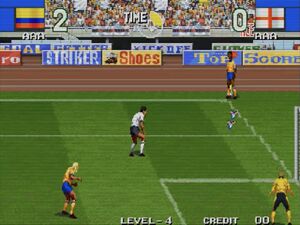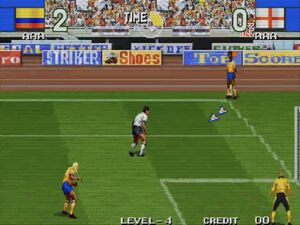Super Sidekicks 2+3/Strategy
Super Sidekicks 2+3 is a game where you can play virtually how you want, if you're able to make it make sense, so strategy is very free-form. This page will talk about situations and specific strategic elements in Super Sidekicks that'll possibly up your game.
Fouling The Ref
Fouling in Super Sidekicks is a massive part of the game as sometimes, when push comes to shove, you'll have to steal the ball of your opponent. Sometimes the ref doesn't care (especially in SSK2) but sometimes you can be anywhere near your opponent and the ref has an issue with it. Solution? Knock That Motherfucker Out Cold. You can shoot the ball at the ref, run into the ref with the ball, place the ball under the ref's legs and slide at the ball, whatever you can think of to knock the ref out might work. This allows you to foul an unlimited amount of times as long as the ref is still out cold.
Corner Kick Scenarios
Corner Kicks in Super Sidekicks 2+3 can be best described like this. Imagine you air block Vlov in MBTL...I don't need to explain much more. The idea is the corner kick scenario is usually extremely bad and a scramble that is always in the player doing the corner kick's favor.
A popular setup amongst players is to aim it directly towards and goal and let the goalkeeper and the player near the goal scramble it out. It forces the opponent to take control of the goalkeeper otherwise the goalkeeper will more than likely fail to block the shot.
Passing with A low passes it and can create trade scenarios where regardless of what the goalkeeper does the ball will magically make it's way into the goal but has a higher chance of failure.
Passing with B high passes it and can create scenarios where a header will be lined up and the goalkeeper might not be able to stop it if the opponent doesn't realise what's going on in time.
Another setup is to pass it away from the goalkeeper, this allows you to line up for a header from far away or try to bait the goalkeeper out manually. This forces the opponent to take control of the player and possibly the goalkeeper as well. This is easier to intercept but a lot safer at the risk of failure since you won't immediately go back to midfield if the goalkeeper catches the ball somehow.
When To Pass And When To Speed Boost
In Super Sidekicks 2, you may be tempted to get one player from one end of the pitch to the other by speed boosting exclusively, and it's not a bad idea but mixing up your options is strong. You can recovery cancel passes so you can get your speed boost off passes as well, you are mainly going to be passing. Remember that the distance you create between you and the ball, while completely realistic for you catch up and with dribble, is wide, so passing and cancelling the recovery might make for more guaranteed scenarios. You also get to keep your formation up better since a player won't be out of formation.
In Super Sidekicks 3, passing is important, your speed boost isn't as good so passing is something you'll need to do more. You speed boost when you need to get to a position faster or save yourself from a tackle; and you'll pass when you need the ball to move from one place to the other.
Passing it back to your goalkeeper
While it might be tempting to steal the ball on defense and run as fast as possible, it might be safer to pass it back to the goalkeeper and have him kick it all the way back to midfield, you might not be able to get out of the fire quick enough so it's crucial you pass it back to the goalkeeper sometimes.
What Makes A Team Good?
Of course, there is going to be an important discussion to have in regards to the meta of Super Sidekicks 2 + 3, Super Sidekicks 2 is a lot simpler to discuss than Super Sidekicks 3, So we'll start with that.
In Super Sidekicks 2+3, The formation of your team and your stats are key, these stats are NOT accurate all the time, two teams with max speed stats will perform significantly different at points (see SSK3 India and South Korea having the same stats, but SSK is S tier and India is bottom 1).
The Formation of the team is 11 players split into 3 positions, Back, Midfield, Front, in that order (4-4-2 as an example is 4 in the back, 4 in the middle, 2 up front). Your formation is important to not because your team's strengths could be held back by your formation, or is helped by the formation. 4-4-2 is desirable, but not particularly mandatory, SSK3 South Korea as an example is amazing on attack, but they run a formation with 3 players up front. This is odd, but, their amazing offensive capabilities really help with the formation, one player missed their strike? There is now two other players willing to back that up.
Where your captain is also helps, usually they're up front.
In Super Sidekicks 3 however, the length of the hair matters A LOT. Long hair players have tricks that Short hair players do and vice versa. They are all valuable, but because the heel flip Long haired players can do can result in unblockable shots, they're ultimately scary as strikers. They're scary in general because heel flip -> dive clears so much of the pitch. They're more well rounded, but scariest up front. Short haired players are more evasive but aren't particularly scary as strikers. Keep this in mind when picking your team!

